THIS GUIDE HAS RECEIVED 7 UPDATES. THE LAST WAS MADE ON 29TH SEPTEMBER, 2025
- I've updated the intermediate racket recommendations to include a new category
Even the best badminton rackets don’t make up for practicing your skills, but getting a suitable racket is one of the easiest wins you can get if your budget allows.
You obviously can’t play like Kento Momota just by getting his racket, but if you’re playing with the wrong one and correct course, you’ll have a lot more fun and it’ll do wonders for your game.
Such was it when I found one that truly suited me well. Despite it being an attacking-based racket, I ended up scoring a ton of points during defense as it complemented my weakness.
That journey started as I got curious about the world’s best badminton rackets, only to discover the special kind of hell it is to find the right fit for me.
There are at least a hundred different rackets available out there, many with similar specs. It feels as if you have to be a racket engineer to understand the difference.
When researching online, articles like this one, suggesting which badminton rackets are best can help narrow down the field, but it only gets you so far. Intellectually understanding how each racket is different is one thing, but the feeling we get when playing with it is a whole other world.
The experience at most offline stores isn’t much better. You can hold the racket and swing it around, but you can’t play-test it to see if it’s a good fit for you in a real game.
It feels as if you’re expected to fork out hundreds of dollars almost blindly. If you’re lucky, you’ll discover a friend who has that exact racket and is willing to let you try it out. It’s not exactly ideal. It’s almost as if we have to adapt to the racket, rather than getting a racket that fits us well.
The big issue when it comes to getting a good badminton racket recommendation is something I refer to as “player-racket fit” and it’s hard to perfect.
Unless you have access to play-test a ton of rackets on court, the secret is not to get stuck looking for the perfect racket model but getting in the right direction – 85% of the way.
For example, if you love power, it’ll be hard for anyone to know your game intimately enough to tell whether you’ll love Yonex’s Astrox 100, 99, or 88D more as they carry very similar specs, but picking any one of them will likely get you most of the way as opposed to getting a speed-based racket like Yonex’s Nanoflare 800.
I bet that you’re here to look at some rackets, so let me show you what’s good first and you can use the table of contents to find more pointers on picking a racket if you’d like.
Alternatively, head over to this mini-guide on how to choose a badminton racket if you’re interested in something more in-depth. If you’re looking for a gift for a badminton player, there’s a guide on that too as rackets might not be the best choice.
- Rackets tested for this guide: 17
- Hours testing rackets on court: 170+ hours
- Updated: 29. September 2025
The best in test overview: the best badminton rackets by skill level
Hey reader, a quick interruption... I’m experimenting partnering with webshops that sell badminton gear, like Amazon. I’ll include links to buy the gear I review and if you do, they’ll pay me a small commission. That doesn’t change your price and you’ll get more play-tested gear as a result but I thought it was fair to let you know. As an Amazon Associate, I earn from qualifying purchases. I appreciate your support, Aske
For beginner + low-intermediate players
1. The beginner + low-intermediate singles player: Yonex Astrox 88 Play (~$55-$75 on Amazon)
2. The beginner + low-intermediate doubles player: Yonex Arcsaber 11 Play (~$55-$75 on Amazon)
For intermediate players
3. The mid-intermediate player mixing singles and doubles games: Yonex Astrox 88D Game (3rd gen.) (~$95-$120 on Amazon)
4. The mid-intermediate doubles player wanting rearcourt power: Yonex Astrox 88D Game (3rd gen.) (~$95-$120 on Amazon)
5. The mid-intermediate doubles player wanting an all around racket: Yonex Arcsaber 7 Tour/Pro (~$150-$219 on Amazon)
6. The mid-intermediate singles player: Yonex Astrox 100 Game (~$135 on Amazon)
7. The intermediate workout racket: Yonex Astrox 99 Game (3rd gen, 2025) (~$135 on Amazon)
For upper-intermediate/advanced (and above) players
8. The top singles players’ weapon of choice: Yonex Astrox 100ZZ (~$269 on Amazon)
9. The popular speedy doubles racket: Yonex Nanoflare 800 (~$245 on Amazon)
10. The surprisingly popular racket of the stars: Yonex Astrox 77 Pro (~$249 on Amazon)
Table of Contents
The best badminton rackets by player-racket fit and playing style
Instead of asking yourself “which badminton rackets are best?” I like to tweak the question to ”what makes the best badminton racket?”
To me, the answer is the one that best solves your problems on court, although not all problems can be solved by a racket. For example, a racket can help you hit the backline if you struggle but it can’t help you move faster around the court.
I’ve noticed three important items where a racket can help:
- If you want more power
- If you want a faster swing speed to hit consecutive shots like a machine gun
- If you want to be more precise (or don’t want a racket that’s too specialized in one area)
In my experience, the biggest win can be gained for people who struggle with power but it comes down to preference.
There are also indirect ways a racket can help you such as if you want to change a habit of smashing too much and add more variety in your play. Then you could get a head light racket to force yourself to play a variety of shots, but I won’t be considering those here.
Rackets by playing style

Deep dive: the best badminton rackets in the world
Let’s get to the good stuff, starting with the rackets for beginner players before moving towards higher skill levels.
1. The beginner + low-intermediate singles player: Yonex Astrox 88 Play

If you’re a beginner or low-intermediate player, you probably want a racket with a flexible shaft to help with the timing in your shots…
And if you’re playing mostly singles with the occasional doubles game, you probably prefer extra power in your racket to make it easier to hit the backcourt when you’re in trouble and don’t have the time to produce a full swing in your shot.
For that, I like the Yonex Astrox 88 Play. It’s the third generation in the series, and while it feels slightly less powerful than the previous generation, it still packs plenty of power.
The lower power and head weight mean it’s easier to control on softer shots at the midcourt and near the net. These often make up the majority of the game at the low intermediate level since even a powerful shot that isn’t hit cleanly won’t fly particularly far.
The 88 Play isn’t all unicorn and rainbows, though. When I was testing the Astrox 88 Play on court, I noticed getting sore in my shoulders during games where I was attacking and smashing a lot. I felt it more than with my usual racket, which is slightly less powerful, but not by much.
If you think this might be an issue, consider the Arcsaber 11 Play instead. It’s not nearly as powerful, which can make singles games more challenging, but you won’t feel as fatigued from playing.
If you’re curious about more details, check out my full Astrox 88 Play review.
2. The beginner + low-intermediate doubles player: Yonex Arcsaber 11 Play
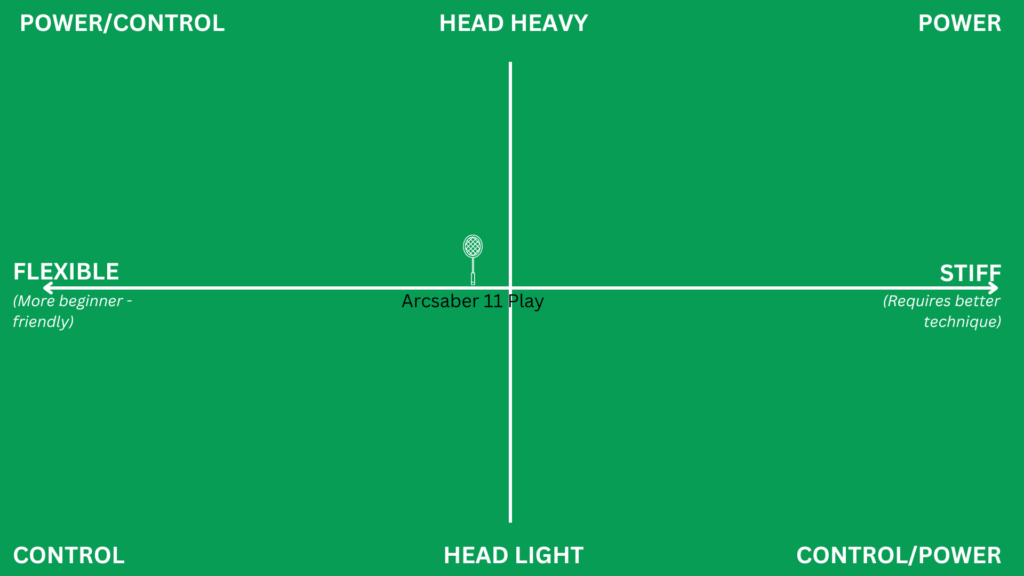
Pros
- A larger sweet spot makes it easier to hit a good shot
- Nice feeling when you hit the shuttle offering more control
- Good all-around with no clear weaknesses
Cons
- It may feel difficult to generate raw smash power if you haven’t trained it
- Not the most supportive racket if you have a pronounced playing style and love playing a single specific shot
The issue with the intermediate level is the big difference between low- and upper-intermediate players in their stroke technique.
If you’re hovering around the intermediate level, having just improved your skills, or are on the verge of doing so as a high beginner, you’re facing a different problem.
For most players including myself, this stage is where you benefit from conquering your one-dimensional smash addiction if you’re looking to improve your skills. Only being able to smash to win rallies makes you an easy target for opponents as they can simply stop lifting or clearing and there will be nothing to smash.
The most effective way I’ve found has been to rob yourself of the extra smash power so you’re forced to come up with other ways to win rallies.
Yonex’s Arcsaber 11 Play is a terrific choice for that as it’s a versatile racket that works well all around the court, and according to Yonex’s marketing, helps with precision. Not to mention that it’s affordably priced too.
Keep in mind that some racket matrices make this racket appear more suitable for beginners than intermediate players. But when you get it on court, you’ll notice that it feels stiffer and less supportive with your shot timing as it has less head weight and that feels nice (more head weight means the racket needs more stiffness to keep the head swinging as you’d expect during the movement).
This is my current racket of choice and I’ve been playing with it for quite some time. You can find my intermediate player’s guide to the best badminton rackets or dive directly into my Arcsaber 11 Play review.
3. The mid-intermediate player mixing singles and doubles games: Yonex Astrox 88D Game (3rd gen.)

A touch faster than the previous generation and with slightly less power, the Yonex Astrox 88D Game 3rd gen. feels more suitable for doubles games.
It’s a good choice if you’re an intermediate player playing both singles and doubles games regularly due to the head heaviness, which offers lots of help with power often preferred during singles games. At the same time, the racket feels surprisingly fast, making it suitable for doubles games, particularly in defense.
The sacrifice comes in a smaller sweet spot, meaning you need to be careful with your shot timing and hitting the shuttle cleanly as there’s less room for error.
If you’re curious, go check out my review of the Astrox 88D Game 3rd generation.
4. The mid-intermediate doubles player wanting rearcourt power: Yonex Astrox 88D Game (3rd gen.)
For your convenience, please see the chapter above.
5. The mid-intermediate doubles player wanting an all around racket: Yonex Arcsaber 7 Tour/Pro

If you’re looking for this type of racket in your badminton journey, you’re probably realizing that one-hit smash wonders aren’t that effective anymore, and power becomes more effective for setting up a later winner…
While counting where I lost the most points in my own doubles games, I’ve found it to be during silly mistakes that shouldn’t happen or poor defense. After improving just the basics of these, I convert about five lost points to winners during each game compared to before.
Switching raw power out for better capabilities all around the court helped with that (which especially improved my defense), and this is where the Arcsaber 7 Tour comes in.
The Yonex Arcsaber 7 Tour and Pro are only available in the lighter 4U weight class, meaning they’re more suitable for doubles games as the pace tends to be faster. I haven’t had a chance to test the Pro edition, but I’ve just tested the more budget-friendly Arcsaber 7 Tour.
It’s my preferred badminton racket for doubles games these days. It’s a nice upgrade from the Arcsaber 11 Play but with a slightly stiffer shaft, that feels crisper, when connecting with the shuttle (but requires better technique as well).
Typically the Tour and Pro editions require better stroke skills than I have, but Yonex’s 7-series skips the Game edition (usually for intermediate players) and makes the Tour and Pro closer to medium flex than super stiff.
If you’re curious, go check out my review of the Astrox 7 Tour.
6. The mid-intermediate singles player: Yonex Astrox 100 Game
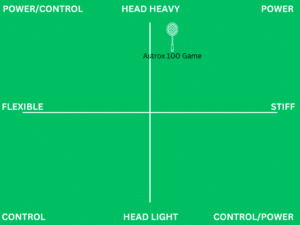
The Astrox 100 Game has been my favorite singles racket since testing it on court. It slices through the air surprisingly fast considering just how much power it packs compared to other powerful rackets.
It feels similar to the Astrox 88D Game (3rd gen.), but slightly slower and more powerful. As such, I found that if you own one and wonder if you should make the switch, it likely isn’t worth it due to their similaries.
When we think of power, we often focus on smash power, but I’ve found that powerful rackets are particularly useful to get that bit extra power when you don’t have time to do a big swing (often in the mid- or rearcout) to send the shuttle back over the net.
The 100 Game is a decent choice if you’re playing both doubles and singles games, with the most focus on singles games, as it’s power is more useful getting yourself out of trouble there.
As a result, the Astrox 100 Game isn’t that easy to control around the net and on tight, soft, shots. In fact, I often found myself using too much power, giving the shuttle too much airtime and making it too easy for my opponents to kill.
7. The intermediate workout racket: Yonex Astrox 99 Game (3rd gen, 2025)

Many of us recreational players enjoy getting on court as a more fun alternative to the gym. With that in mind, I figured I’d suggest one of the best badminton rackets for a good workout.
That means playing with it will make you feel fatigued, and your muscles will work that bit harder than with many other rackets. All the head weight and power this Yonex Astrox 99 Game (3rd generation launched in 2025) offers make it feel more suitable for singles games rather than doubles.
You’ll get plenty of power in your overhead shots like clears and smashes, along with extra power for blocks, even if your technique isn’t amazing.
On the other hand, changing grips during fast drive duels in doubles is more difficult and soft shots require some getting used to.
If this sounds like something for you, head over to the in-depth Astrox 99 Game (3rd gen) review.
7. The top singles players’ weapon of choice: Yonex Astrox 100ZZ

Before diving into this racket, let me be transparent: I haven’t tested it as it’s too demanding for my skillset. Instead, I’ve based it on how popular it is among the professional players on the BWF World Tour.
This is Viktor Axelsen’s, the men’s singles champion’s, preferred racket.
In fact, it’s also the racket used by Akane Yamaguchi, the #1 in women’s single, along with Takuro Hoki (#4 in MD), and Chen Qing Chen (#1 in WD).
I’ve play-tested the intermediate version of this racket, the Astrox 100 Game and if that’s anything to go by, it’s a killing machine on the court if you’re into attacking and smashing.
There are older rackets with more raw power, but I understand that they are difficult to use except in those rare cases where everything is positioned for the perfect smash and you’re not under pressure.
Instead, this racket seemingly packs almost as much power but is reported to be smoother throughout the entire game, especially when you’re under pressure.
8. The popular speedy doubles racket: Yonex Nanoflare 800
Before diving into this racket, let me be transparent: I haven’t tested this racket as it’s too demanding for my skillset. Instead, I’ve based it on how popular it is among the professional players on the BWF World Tour.
Yonex’s Nanoflare 800 is their flagship racket when it comes to speed, and speedy it is. It is chosen as the weapon of choice by top players like Chiharu Shida (#2 in WD), Lee Yang (#12 in MD), Jia Yi Fan (#1 in WD), and Thom Gicquel (#6 in XD).
The racket’s unusually slim shaft reportedly slices through the air and you’ll be well-prepared to counter smashes or handle fast drive shots. At the same time, I understand that you’ll still be able to play long clears without problems but you might find it a challenge to get a power smash going, as is common for this style of racket.
It’s easy to play with which means that there’s little adoption time if you’re switching from a different racket. That also comes in handy when you’re having an off day.
9. The surprisingly popular racket of the stars: Yonex Astrox 77 Pro
As I was researching this racket, I was surprised to discover just how many top players are using this all-around racket. In fact, it’s the racket used by the most top players relative to how high their ranking is, as far as I can count.
Korean An Se Young (#1 in WS), Chen Yu Fei (#4 in WS), Muhammad Ardianto and Fajar Alfian (both #1 in MD), Huang Ya Qiong (#1 in XD), and Huang Dong Ping (#4 in XD).
It’s counterintuitive as this racket isn’t designed to be amazing in one particular area but rather performs well all around with no clear weaknesses.
I wasn’t sure whether this racket would be too demanding for my skillset, so I ended up buying it with my own money and testing it on court for ten hours.
That turned out to be true with smashes where I struggled to perform clean hits consistently. On the other hand, I enjoyed playing with it during all other areas on court. You can find my deep dive review here.
Takeaways
- Buying the best badminton racket is a special kind of hell as there are what feels like a million different options and it’s challenging to figure out which one best suits you without testing them against your existing one
- Buying in a store isn’t much better as you get to hold the racket but that doesn’t tell you much about how it truly plays against your existing one when it comes down to brass tacks
- If you’re a Yonex fanboy, consider reading this guide on the best Yonex rackets next or browse the racket catalog

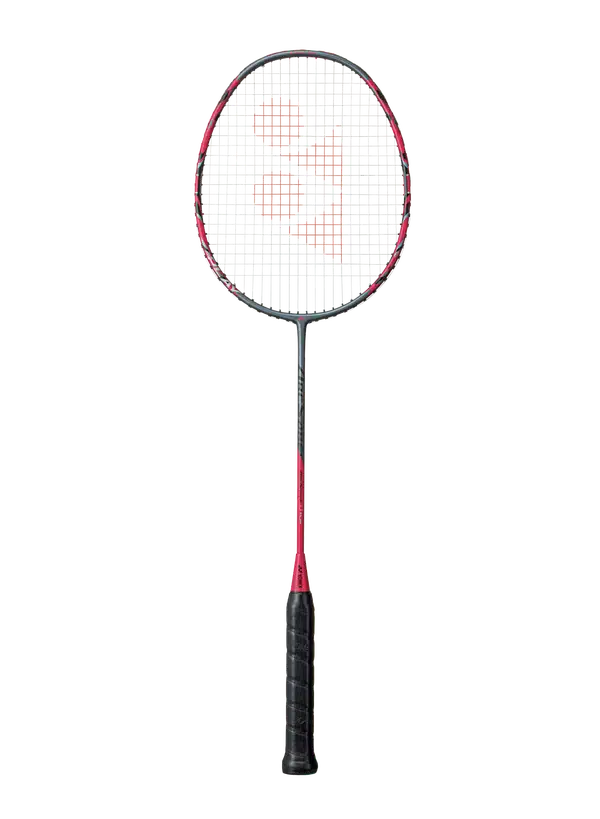
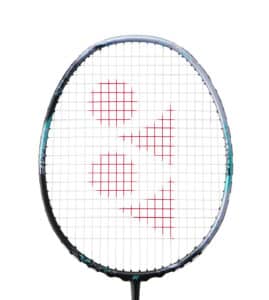
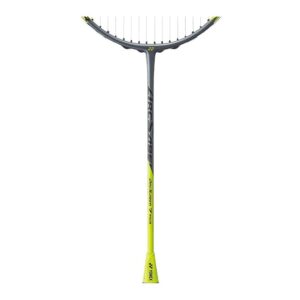

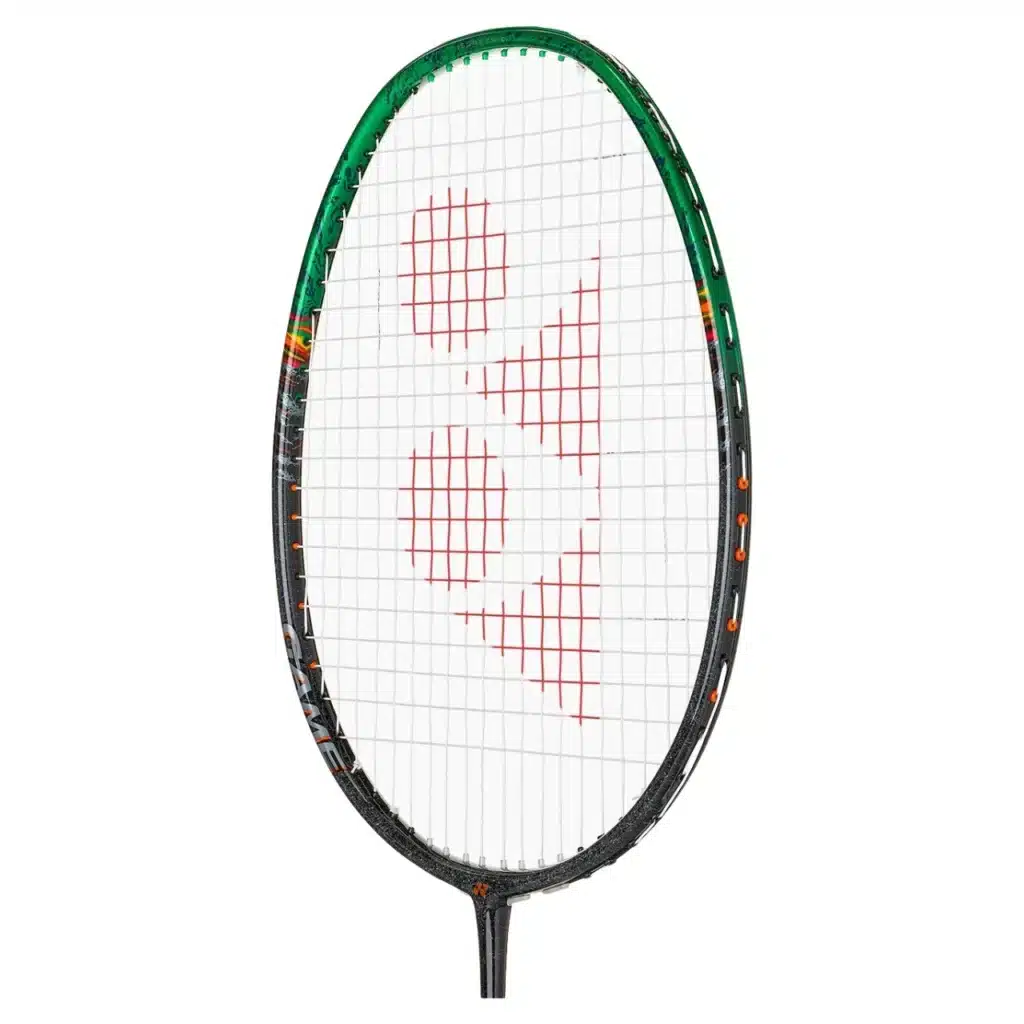

1 comment
Recently discovered the Nanoflare 700LT & 700Pro in 5U flavour. Those are some sweet fly swatters, I would say.